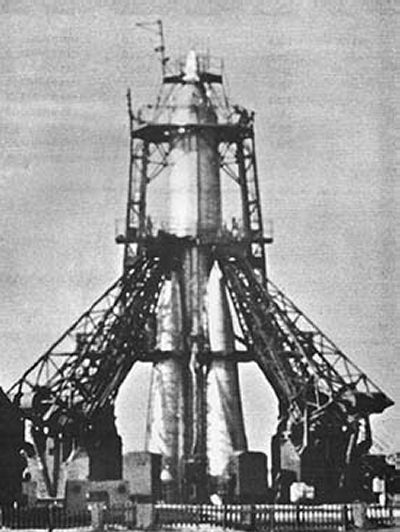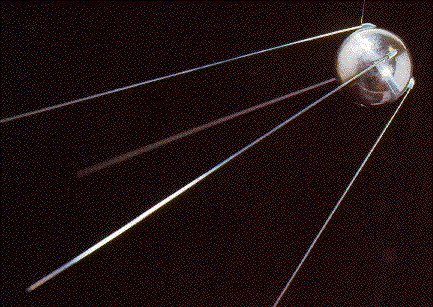4 October 1957: The Shot Heard (and Seen) Around the World
The space race begins with the launch of Sputnik (Russian for traveler) by an indigenously developed and modified R-7 ICBM (NATO Codename SS-6 Sapwood).
R-7 Семёрка/SS-6 SAPWOOD
Design work began at OKB-1 (later S.P. Korolev Rocket and Space Corporation Energia) in Kaliningrad (now Korolev) and other divisions in 1953 with the requirement for a two-stage missile of 170 tons with a range of 8,000 km carrying a 300 kg warhead. Following first ground tests in late 1953 the initial design was heavily reworked and the final design was not approved until May 1954. The first testing of the new missile, codenamed 8K71, was on May 15, 1957 from Baikonur Cosmodrome. A fire in a strap-on rocket led to an unintended crash 400 km from the site. Following another unsuccessful test the first successful long flight, of 6,000 km, was made on August 21. It was announced by TASS on August 26. A modified version of the missile placed Sputnik 1 in orbit from Baikonur on October 4th.
Спутник/SPUTNIK
Sputnik 1 (Russian: "Спутник-1", "Satellite-1", or literally "Co-traveler-1" byname ПС-1 (PS-1, i.e. "ПроÑтейший Спутник-1", or Elementary Satellite-1)) was the first artificial satellite to be put into geocentric orbit. Launched by the Soviet Union on October 4, 1957, it was the first satellite of the Sputnik program.
The satellite helped to identify the density of high atmospheric layers by its orbit change and provided data on radio-signal distribution in the ionosphere. Because the satellite’s body was filled with pressurized nitrogen, Sputnik 1 also provided the first opportunity for meteorite detection, as losses in internal pressure due to meteoroid penetration of the outer surface would have been evident in the temperature data. The unanticipated announcement of Sputnik 1’s success precipitate d the Sputnik crisis in the United States and ignited the so-called Space Race within the Cold War.
Sputnik-1 was set in motion during the International Geophysical Year from the 5th Tyuratam range in Kazakh SSR (now Baikonur Cosmodrome). The satellite travelled at 29,000 kilometers (18,000 mi) per hour and emitted radio signals at around 20.005 and 40.002 MHz which were monitored by Amateur radio operators throughout the world. The signals continued for 22 days until the transmitter batteries ran out on October 26, 1957. Sputnik 1 burned as it fell from orbit upon reentering Earth’s atmosphere, after traveling about 60 million km (37 million miles) in orbit.
Movies below the fold…





